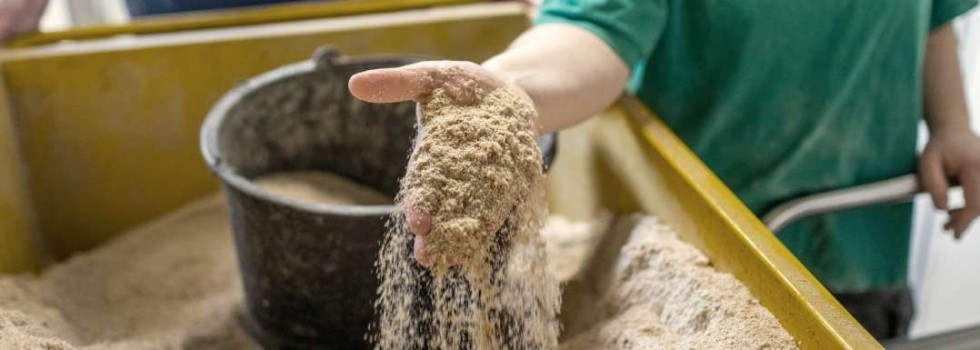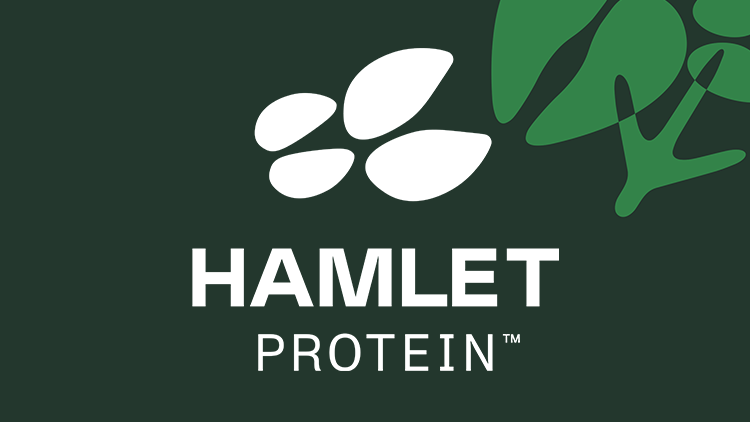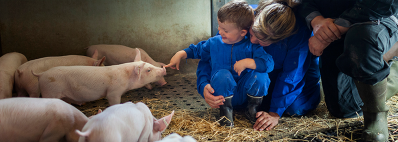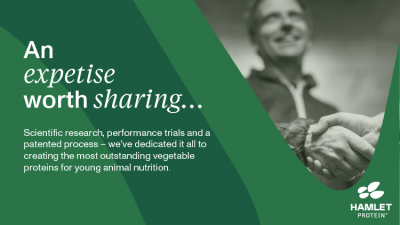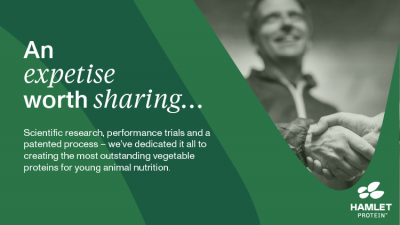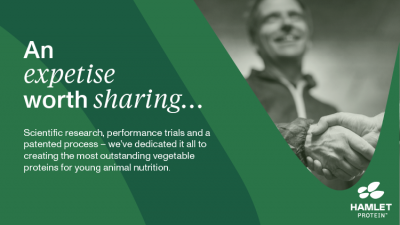Promotional Features
High speed protein digestion, a new dimension in protein source evaluation
Knowing the protein kinetics of each protein source will allow nutritionists to formulate diets with a higher protein biological value, optimising animal performance and therefore feed cost, and reducing nitrogen excretion into the environment.
Hamlet Protein has been conducting research during the last two years and discovered there are large differences in protein kinetics between protein sources.
Dr. Jessika van Leeuwen, global category manager swine, says: “We always knew that improving protein digestibility through the reduction of antinutritional factors as achieved by Hamlet Protein is crucial, but we also had the feeling there was more to our products than that. Investigating how the protein kinetics of our products compare to other protein sources showed us what that difference was.”
The results of this research have been published recently at the ASAS-CSAS-WSASAS meeting in the US.¹
What is protein kinetics?
The science of digestion kinetics describes the process of hydrolysis and absorption of nutrients in the intestines. Thus, protein kinetics means the dynamics of protein hydrolysis and absorption in the small intestine. In other words, how fast and where in the digestive tract dietary protein is digested, absorbed and released into the blood stream. Both the speed and the location of absorption influence what the amino acids will be used for subsequently.
Traditionally, a protein ingredient is evaluated based upon its protein content (CP) and ileal digestibility coefficient of the amino acids it contains. However, the digestibility coefficient only considers how much protein is left at the end of the small intestine and does not say anything about digestion and absorption speed-and location.
Two protein sources can have similar ileal digestibility coefficients but may differ largely in the speed and site of digestion, and absorption (Figure 1). Consider for instance blood meal and high protein soybean meal (SBM-HP) which both show similar digestibility coefficients at the end of the small intestine (after which is assumed no enzymatic protein digestion occurs anymore).
For blood meal, however, a lot more protein is hydrolysed already in the first part of the small intestine (proximal jejunum) while for SBM-HP more is hydrolysed in more distal parts of the small intestine. In this study, this means that the protein digestion is faster for blood meal than for SBM-HP.
Van Leeuwen adds: “Protein kinetics is a more accurate description of what actually happens with the protein inside the animal than digestibility alone. Protein kinetics considers not only that a protein is digested but also where it is digested, and the resulting amino acids are absorbed.”
Figure 1: Apparent digestibility coefficients in different parts of the digestive tract.²
Why speed matters
Digestion speed is important because the most efficient hydrolysation and absorption occurs in the jejunum, a part of the small intestine which is closer to the stomach. The jejunum is more efficient in absorbing amino acids than the ileum which is further away from the stomach. The reason for this is that glucose is abundantly available as an energy source for the intestinal cells in the jejunum that absorb the amino acids.
This means that they can perform optimally and therefore, a greater proportion of amino acids pass into the bloodstream. Consequently, a smaller proportion needs to be oxidised to generate energy. Conversely, less glucose is available further down in the ileum. Therefore, intestinal cells located here will have to use a larger proportion of the amino acids as an energy source, so that the functions of these intestinal cells can continue to be carried out.3,4,5
Furthermore, insulin growth factor (IGF), which regulates the deposition of amino acid (AA) in tissues, reaches peak levels soon after feed consumption, which favours the deposition of AA during peak levels of IGF. So, the faster a protein is hydrolysed and absorbed, the more of the protein will be used for protein deposition. Fast absorbable protein ingredients improve nitrogen (N) retention and consequently growth and feed efficiency of the animals.
Faster protein also reduces the risk of protein fermentation in the hindgut. The rate of protein hydrolysis, the consequent rate of AA absorption, and the synchronisation of absorption of AA from different dietary protein sources are especially important in young animals. This is due to their high AA requirements for the synthesis of muscle tissue and vital organs. Therefore, protein kinetics are more indicative of feed efficiency and protein deposition than the digestibility coefficient of the protein ingredient.
Van Leeuwen adds: “Young animals have a very high protein requirement but underdeveloped digestive capacity. They need a lot of protein to further develop their organs, while not fully equipped to extract all the required amino acids from the protein in the diet.”
Formulating diets considering protein kinetics
In the current practice of feed formulation, digestible amino acids and net or metabolizable energy contents are used as fixed values of feed ingredients to optimise diets. This is quite convenient but limited as it ignores the variation in nutrient kinetics of different ingredients and does not account for interactions happening between ingredients before and after absorption.
The faster the protein source, the more readily available it becomes for the animal, but there also needs to be synchronization in AA absorption. If the absorption of AA from different ingredients is not well synchronised, the deposition of AA in tissues is reduced and the N excretion via urine is increased. So, kinetics is especially important when formulating diets with low CP and synthetic amino acids.
Hamlet Protein collaborated with Aarhus University to test the kinetics of a variety of protein sources as the best way to determine protein kinetics is by mimicking digestion in vitro. Results of these studies revealed that from all vegetal protein sources, Hamlet Protein products show the fastest protein hydrolysis in vitro which theoretically also means the fastest kinetics in the animal gastrointestinal tract (see figure 2).
Figure 2: Speed of protein hydrolysation as measured by the hydrolysis constant k[µL/(mole*s); µL=microliter NaOH needed to keep pH at 8 during hydrolysis (acid is released) and s=seconds for 7 different soy-based protein ingredients when incubated with proteolytic enzymes for 120 minutes.
Values in bubbles indicate the percentage difference to ESBM. The higher the k-value, the faster the hydrolysis and thus absorption. SBM=soybean meal; ESBM = enzyme-treated soybean meal (Hamlet Protein); SPC=soy protein concentrate; ExS=extruded soy; FSBM=fermented soybean meal; PPC=potato protein concentrate; FM=fish meal.
The fastest vegetal protein
The unique production process of Hamlet Protein using enzymatic treatment does not only effectively reduce the content of anti-nutritional factors, but it also modifies protein characteristics in such a way that it becomes more accessible for proteolytic enzymes, resulting in a very fast protein source. Protein from Hamlet Protein hydrolyses faster than SBM and a lot faster than protein from SPCs.
Van Leeuwen adds: “The results clearly show that there is a large difference between protein sources.
"The Hamlet Protein portfolio outperforms all vegetal protein sources when it comes to kinetics, but also is faster than the tested animal proteins. In the coming months we will be testing even more protein sources that are commercially available; this way we will build a database for our customers so they can evaluate protein sources based upon their protein kinetics.”
References
1. Bible, et al. (2023). In-vitro evaluation of protein kinetics of soy-based ingredients. Proceedings ASAS CSAS WASAS.
2. Toghyani, M.; L. R. McQuade, L.R.; Mclnerney, B.V.; et al. (2020). Initial assessment of protein and amino acid digestive dynamics in protein-rich feedstuffs for broiler chickens. PLoS One. 15(9): e0239156.
3. van den Borne, J.J.G.C.; Schrama, J.W.; Heetkamp, M.J.W.; et al. (2007). Synchronising the availability of amino acids and glucose increases protein retention in pigs. Animal 1:666-674.
4. Liu, S.Y.; Selle, P.H.; (2017). Starch and protein digestive dynamics in low-protein diets supplemented with crystalline amino acids. Anim. Prod. Sci., 57, pp. 2250-2256.
5. He, W.; & Wu, G. (2022). Oxidation of amino acids, glucose, and fatty acids as metabolic fuels in enterocytes of developing pigs. Amino acids. 54(7), 1025–1039.
